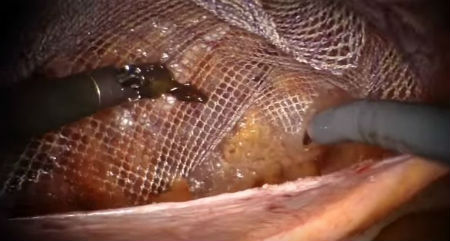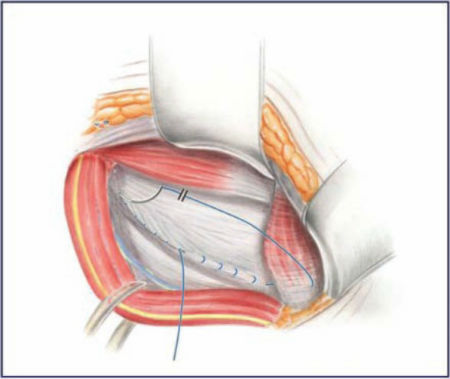
If you have reviewed the symptoms and confirmed your diagnosis, it may be time to begin looking for a specialist who can perform surgery to provide a permanent solution to cure your debilitating groin pain.
Get the ULTIMATE Sports Hernia Master Guide with 30+ included resources, an in-depth rehabilitation program, tips, tricks, and more! Successfully diagnose, treat, and cure your sports hernia with this complete master guide created by a sports hernia specialist. Note that it is still highly recommended to read this article in full to understand how to get the most out of the guide to treat and cure your sports hernia or groin pain.
Before we take a look at the sports hernia surgery cost, an important point needs to be made.
While not all cases require surgical intervention, most do. In a notable report published in the International Journal of Sports Physical Therapy, they concluded that conservative treatment was a viable solution.
However there’s a catch—this only appears to be the case for individuals who receive a speedy diagnosis immediately following injury. These individuals are then able to begin the proper rehabilitation program as soon as possible. Obviously, this isn’t going to be the case 100% of the time. As you will see in just a few paragraphs below, many people experiencing long-term symptoms found relief through following the correct rehab protocol.
While the injury will not degrade and get worse with time, your chances of healing without going over the knife decrease exponentially with each passing week. This means as soon as you realize you are injured begin the sports hernia treatment plan.
If you reach week 6 of the rehab program and have seen a strong decrease in your pain levels and symptoms, it is very likely you may be able to heal fully by week 10. Many people with long-standing pain have tried the rehab program and found great success.


But if you fall into the larger category of people who do require surgery, you first need to know your options—and that includes price.
Sports Hernia Surgery Cost: With and Without Insurance
One of the concerns on your mind when preparing to finally tackle your pain with the help of a doctor will undoubtedly be the price tag.
While insurance plans differ widely and coverage plans are highly person-dependent, you can rest assured that the cost isn’t financially devastating.
Depending on where you have the procedure performed, be prepared to pay $5,000-$10,000 before insurance kicks in. This includes costs associated with renting the operating room, an anesthesiologist, along with other hospital fees.
Because the injury has grown in popularity, causing it to be much more understood and easier to successfully diagnose, it is very likely that your health insurer will cover at least part of the costs.
If you are looking to get surgery in the UK your prices will most certainly differ from those in the United States.
The final number you see on your bill will largely depend on the type of surgery performed as well: mesh vs. the minimal repair technique.
Because the minimal repair approach requires a specialist trained in the procedure, it will almost always be more expensive than the mesh approach that can be performed by a general doctor.
But as you will learn below, both are not created equal—and trying to cut costs may leave you with permanent, untreatable pain.
Sports Hernia Mesh Surgery
One of the available methods for treating the injury involves placing mesh inside the wound to provide stability to the area so that it can begin to heal. While mesh is a suitable solution for a much more common traditional inguinal hernia, it is not recommended for Gilmore’s groin.
If mesh is used during the procedure, it can lead to long-term issues. It can attach and fuse to nerve endings, leading to chronic pain that is often times literally untreatable. Furthermore, it can become stiff and harden from fibrosis, leading to even further tissue damage.

It is sometimes done with the help of robotic arms.
If you have already undergone the mesh procedure, you may be able to have a second operation to remove it and additionally perform the much more successful approach involving sutures.
One commenter provided his experience with mesh on a video recently pushed on our YouTube channel. While it definitely isn’t ideal, it is at least reassuring to know the web-like material it can be removed after the fact. Note however that the longer mesh has been inside your body, the harder it will be to remove without doing significant damage to surrounding tissues.

A very large forum post on a running website from 2004 (now 165 pages long) includes many more detailed first-hand accounts of individuals who have regretted it.
One study published in the Mini-Invasive Surgery Journal touts “hybrid mesh” that has lightweight polypropylene sandwiched between layers of biological mesh. While Dr. Edelman concluded that the initial results look promising, the study’s method’s don’t provide as optimistic of an outlook. It used just 16 participants: all male and between the ages of 18 to 43—hardly enough to claim statistical significance.
Because this method can be done by general doctors, it will be cheaper in almost all cases.
Luckily, this isn’t the case for the alternative approach.
Minimal Repair Technique Developed by Dr. Ulrike Muschaweck of Germany
The minimal repair technique is an alternative approach developed by the surgical chief and founder of the Hernia Center in Munich, Germany.
Beginning her career as a surgeon in 1989, she advanced quickly and began her own private practice just 4 years later in Munich. It was there that she invented the minimal repair technique specifically designed to treat sportsman’s groin hernias (the phrase more commonly used in UK and other parts of Europe).
Throughout a 10 year period, she had the opportunity to work with many elite athletes from all over the globe while optimizing the procedure. Amazingly, many of her patients returned to activity within days.
In 2003 her center introduced the final version to the medical community.
Since then, she has treated more than 27,000 people and has gone on to instruct other doctors in the United States and beyond.
Utilizing tension-free sutures, mesh is avoided completely. This provides full mobility and elasticity to the muscles of the groin and abdominals.
Because this method requires a specialist, expect to pay towards the higher end of the $5,000-$10,000 price tag.
Sports Hernia Surgery Procedure
If you go down the mesh route, the process is pretty straight forward. A video by Dr. Konstantinidis of the Athens Medical Group in Greece goes into more detail. One additional point to note is that it requires general anesthesia which can cause more issues than localized anesthetics.
The minimal repair procedure is very different:
- Local anesthesia is applied
- A small inguinal incision is made
- Severity of injury tested by providing digital stimulation to the posterior inguinal wall (transversalis fascia)
- Once the weak area is located, the fascia tissue of the inguinal wall is cut while keeping surrounding tissue intact

The posterior inguinal wall, otherwise known as the transversalis fascia
- Genital branch of the genitofemoral nerve is assessed and partial removal is considered if there is excessive nerve damage
- Continuous suture is used to close original fascia incision
- Tension and pressure at the pubic bone decreased through Muschaweck’s innovative approach of including the lower abs in last part of the suture

Tension-free suture approach (credit: Muschaweck, Ulrike, and Luise Masami Berger. “Sportsmen’s Groin—Diagnostic Approach and Treatment With the Minimal Repair Technique: A Single-Center Uncontrolled Clinical Review.”)
- Inguinal incision is closed
Sports Hernia Surgery Complications
One of the most common complications revolves around the use of mesh. Explained above, the porous material can bind to your nerves, causing entrapment leading to lifelong pain. The main nerve in question is the genital branch of the genitofemoral nerve.

Genital branch of the genitofemoral nerve
Conversely, the suture approach aims to decompress this nerve; Muschaweck believes this is actually one of the leading causes of long-term pain, especially in those who receive help but never get better.
Beyond that, mesh can become very hard over time. On top of permanent pain, this stiffness reduces flexibility and mobility which can contribute to other knee, hip, and lower back injuries.
Infections also become a concern when you place foreign materials inside your body. While the hybrid material pointed to earlier may help with that, why risk it when you don’t have to?
On top of infections, hardening, and trapping nerves, it can migrate and move around inside you after the procedure. In some of the worst cases, this leads to penetration of the bladder or bowel. In males, testicular temperature may also be lowered due to a foreign material reaction.
An in-depth review published by Muschaweck further confirms the indirect approach is a better method for avoiding possible issues and complications.
“In comparison with [other methods], the Minimal Repair technique has advantages:”
- No prosthetic material inserted into the body
- General anesthesia and associated complications are avoided by using local anesthetics
- Lower risk of severe problems
- Faster recovery
Sports Hernia Surgery Success Rate
Unfortunately, no good case studies or reviews have been published on the mesh procedure. This leaves us with mostly anecdotal evidence suggesting no higher than a 70% rate of success at most (and that is likely being generous).
On the flip side, there is much published evidence for the alternative minimal approach. In a review of 2,000 minimal repairs, only 3 patients were unable to be permanently fixed. To put it another way, that is a 99.85% success rate.

Dr. Ulrike Muschaweck and a satisfied patient
Sports Hernia Surgery or Not?
If you try sports hernia treatment without surgery but are unsuccessful after you reach the 6-week mark, finding a specialist to perform the procedure is most likely the only way to find permanent pain relief.
